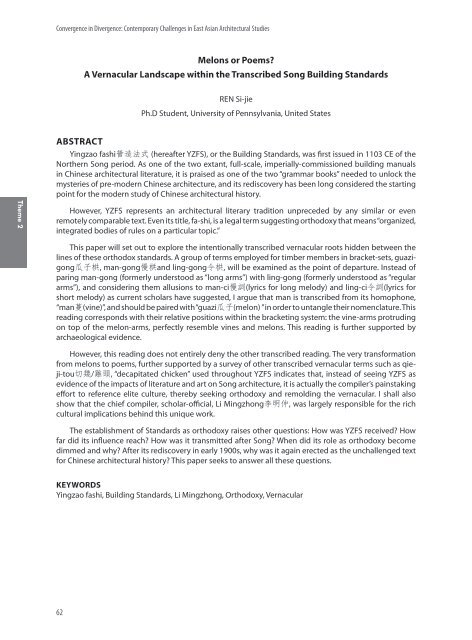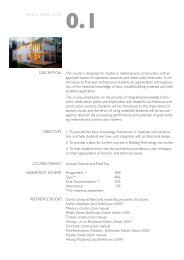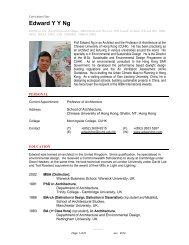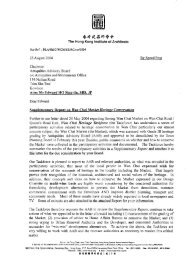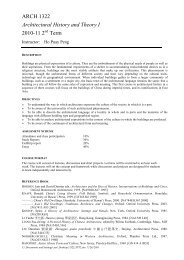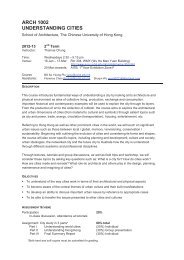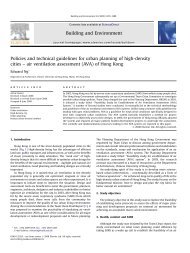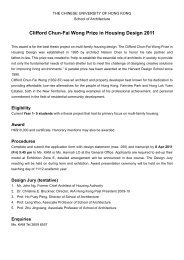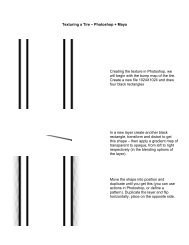CONVERGENCE in DIVERGENCE - School of Architecture - The ...
CONVERGENCE in DIVERGENCE - School of Architecture - The ...
CONVERGENCE in DIVERGENCE - School of Architecture - The ...
You also want an ePaper? Increase the reach of your titles
YUMPU automatically turns print PDFs into web optimized ePapers that Google loves.
Convergence <strong>in</strong> Divergence: Contemporary Challenges <strong>in</strong> East Asian Architectural Studies2012 International Conference on East Asian Architectural Culture, Hong KongMelons or Poems?Recognitions <strong>of</strong> the Vernacular <strong>Architecture</strong> by Local People <strong>in</strong> JapanA Vernacular Landscape with<strong>in</strong> the Transcribed Song Build<strong>in</strong>g StandardsSUZUKI ArnoREN Si-jieLecturer, Kyoto University, Japan<strong>The</strong>me 2Ph.D Student, University <strong>of</strong> Pennsylvania, United StatesABSTRACTY<strong>in</strong>gzao fashi 營 造 法 式 (hereafter YZFS), or the Build<strong>in</strong>g Standards, was first issued <strong>in</strong> 1103 CE <strong>of</strong> theNorthern Song period. As one <strong>of</strong> the two extant, full-scale, imperially-commissioned build<strong>in</strong>g manuals<strong>in</strong> Ch<strong>in</strong>ese architectural literature, it is praised as one <strong>of</strong> the two “grammar books” needed to unlock themysteries <strong>of</strong> pre-modern Ch<strong>in</strong>ese architecture, and its rediscovery has been long considered the start<strong>in</strong>gpo<strong>in</strong>t for the modern study <strong>of</strong> Ch<strong>in</strong>ese architectural history.However, YZFS represents an architectural literary tradition unpreceded by any similar or evenremotely comparable text. Even its title, fa-shi, is a legal term suggest<strong>in</strong>g orthodoxy that means “organized,<strong>in</strong>tegrated bodies <strong>of</strong> rules on a particular topic.”This paper will set out to explore the <strong>in</strong>tentionally transcribed vernacular roots hidden between thel<strong>in</strong>es <strong>of</strong> these orthodox standards. A group <strong>of</strong> terms employed for timber members <strong>in</strong> bracket-sets, guazigong瓜 子 栱 , man-gong 慢 栱 and l<strong>in</strong>g-gong 令 栱 , will be exam<strong>in</strong>ed as the po<strong>in</strong>t <strong>of</strong> departure. Instead <strong>of</strong>par<strong>in</strong>g man-gong (formerly understood as “long arms”) with l<strong>in</strong>g-gong (formerly understood as “regulararms”), and consider<strong>in</strong>g them allusions to man-ci 慢 詞 (lyrics for long melody) and l<strong>in</strong>g-ci 令 詞 (lyrics forshort melody) as current scholars have suggested, I argue that man is transcribed from its homophone,“man 蔓 (v<strong>in</strong>e)”, and should be paired with “guazi 瓜 子 (melon) ” <strong>in</strong> order to untangle their nomenclature. Thisread<strong>in</strong>g corresponds with their relative positions with<strong>in</strong> the bracket<strong>in</strong>g system: the v<strong>in</strong>e-arms protrud<strong>in</strong>gon top <strong>of</strong> the melon-arms, perfectly resemble v<strong>in</strong>es and melons. This read<strong>in</strong>g is further supported byarchaeological evidence.However, this read<strong>in</strong>g does not entirely deny the other transcribed read<strong>in</strong>g. <strong>The</strong> very transformationfrom melons to poems, further supported by a survey <strong>of</strong> other transcribed vernacular terms such as qieji-tou切 幾 / 雞 頭 , “decapitated chicken” used throughout YZFS <strong>in</strong>dicates that, <strong>in</strong>stead <strong>of</strong> see<strong>in</strong>g YZFS asevidence <strong>of</strong> the impacts <strong>of</strong> literature and art on Song architecture, it is actually the compiler’s pa<strong>in</strong>stak<strong>in</strong>geffort to reference elite culture, thereby seek<strong>in</strong>g orthodoxy and remold<strong>in</strong>g the vernacular. I shall alsoshow that the chief compiler, scholar-<strong>of</strong>ficial, Li M<strong>in</strong>gzhong 李 明 仲 , was largely responsible for the richcultural implications beh<strong>in</strong>d this unique work.ABSTRACTVernacular architecture is a good model <strong>of</strong> susta<strong>in</strong>able design that fits <strong>in</strong> the natural climate andsocial context <strong>of</strong> its particular region. Traditional folklore residences <strong>in</strong> Japan show good examples. <strong>The</strong>yare, however, fac<strong>in</strong>g difficulty <strong>in</strong> preservation and utilization, especially when the cultural-asset laws andlocal build<strong>in</strong>g codes make it difficult for the owners to use their home to its best function. Even thoughthose folklore residences are energy efficient, zero emission and low <strong>in</strong> environmental impact, they mayno longer be ‘susta<strong>in</strong>able’ <strong>in</strong> the modern economic and social environment with westernized lifestyle <strong>of</strong>people. <strong>The</strong> author <strong>in</strong>terviewed owners <strong>of</strong> cultural asset residences <strong>in</strong> Japan and identified obstacles forthe vernacular architecture <strong>in</strong> Japan to rema<strong>in</strong> susta<strong>in</strong>able.Fujioka Residence, for example, is over 250 years old shop-house <strong>in</strong> Nara, <strong>in</strong> the west <strong>of</strong> Japan. For itis designated as an important cultural asset by law, the owner has the obligation to preserve their houseas it was orig<strong>in</strong>ally, even though the traditional carpentry and the orig<strong>in</strong>al natural materials cost them afortune nowadays. <strong>The</strong>y are, however, one <strong>of</strong> rare families who still live <strong>in</strong> and use the historical houseunder this circumstance. <strong>The</strong> author observed and <strong>in</strong>terviewed Fujioka family from 2001 to 2011, andfound that their f<strong>in</strong>ancial and psychological burdens were caused by the lack <strong>of</strong> understand<strong>in</strong>g by localpeople, <strong>in</strong>clud<strong>in</strong>g the government, researchers, educators, tourists and neighbors.<strong>The</strong> author also <strong>in</strong>terviewed some other owners <strong>in</strong> the east <strong>of</strong> Japan. <strong>The</strong>ir properties were damagedfrom the 2011 earthquake and tsunami, but the owners are still try<strong>in</strong>g to restore the houses and keepthem function<strong>in</strong>g.A survey research on 280 students, <strong>in</strong>clud<strong>in</strong>g both domestic and <strong>in</strong>ternational, shows that they all canunderstand the significance and value <strong>of</strong> the vernacular architecture as a model for an environmentallyfriendly lifestyle. <strong>The</strong> result also suggested a possibility <strong>of</strong> utiliz<strong>in</strong>g those historical residences forenvironmental education. However, other surveys on cultural asset owners and general public show thetotal lack <strong>of</strong> understand<strong>in</strong>g toward historical houses, and local Japanese people had less understand<strong>in</strong>gthan visitors from western countries. <strong>The</strong> lack <strong>of</strong> understand<strong>in</strong>g <strong>of</strong>ten leads developers to make wrong andirreversible alteration on the vernacular architecture. We have to f<strong>in</strong>d ways to make proper <strong>in</strong>troductions<strong>of</strong> the vernacular architecture and enlighten local people with their irreplaceable values.<strong>Architecture</strong> <strong>of</strong>Negotiation<strong>The</strong> establishment <strong>of</strong> Standards as orthodoxy raises other questions: How was YZFS received? Howfar did its <strong>in</strong>fluence reach? How was it transmitted after Song? When did its role as orthodoxy becomedimmed and why? After its rediscovery <strong>in</strong> early 1900s, why was it aga<strong>in</strong> erected as the unchallenged textfor Ch<strong>in</strong>ese architectural history? This paper seeks to answer all these questions.KEYWORDSDesignation, Preservation, Utilization, Education, EnvironmentKEYWORDSY<strong>in</strong>gzao fashi, Build<strong>in</strong>g Standards, Li M<strong>in</strong>gzhong, Orthodoxy, Vernacular62 63


